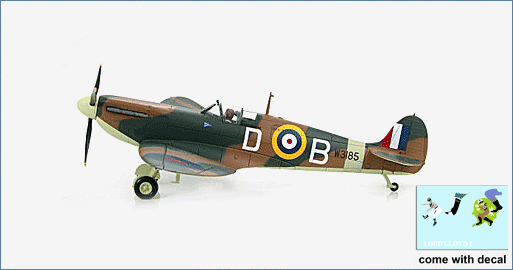Air Power Series>1:48 die-cast display model>Spitfire>HA7807
Spitfire Mk.VA flown by Wing Commander Douglas Bader, No.616 Sqn., Tangmere Wing, RAF Tangmere, England, March-August 1941

General Background
The Spitfire V was supposed to be an interim fighter based on the Spitfire Mk. I. The aircraft was given a larger Merlin engine so it could perform with the Bf-109s. The Mk.V had metal ailerons that improved the handling characteristics dramatically and continued to use the Type A wing with 8 × .303" Browning machine guns. The oil cooler was revised to eliminate over heating. Of the 6,479 Spitfires produced in all variants only 94 Va variants were made.
The Aircraft
Douglas Robert Steuart Bader lost both legs in an RAF aircraft crash and wasn't allowed to fly again but in 1939 using artificial legs he regained his flying ability and with WWII looming he a was allowed to rejoin the RAF. In June 1940 he became Squadron Leader with the No. 242 Canadian Squadron and in 1941 became Wing Commander. In August 1941 Bader's Spitfire was shot down and he spent the remainder of the war as a POW but not before obtaining 22 kills and 6 probables.
Specifications :
| Basic Information : | |
| Role: | Single Seat Fighter / Fighter Bomber |
| Design: | Reginald Joseph Mitchell |
| Manufacturer: | Supermarine Aviation Works (Vickers) Limited also built by Vickers-Armstrong, Castle Bromwich and Westland Aircraft |
| Powerplan: | (Mk I, III) 1,030 hp Rolls-Royce Merlin II liquid cooled V-12 |
| (Mk II) 1,175 hp Merlin XII | |
| (Mk V) 1,440 hp (1074 kW) Rolls-Royce Merlin 45 | |
| (Mk VI) 1,415 hp Merlin 47 (Mk VII, VIII, IX) 1,660 hp Merlin 61 | |
| (Mk X) Merlin 77 (Mk XI) 1,760 hp Merlin 63A or 1,655 hp Merlin 70 | |
| (Mk XII) 1,735 hp Rolls-Royce Griffon III or IV | |
| (Mk XIII) 1,620 hp Merlin | |
| (Mk XIV, XVIII, XIX and type 21) 2,050 hp Griffon 65 with a two-stage supercharger (type 22) 2,375 hp Griffon 65. | |
| Performance: | (Mk VA) Maximum speed 369 mph (594 km/h) at 19,500 ft (5945 m) service ceiling 36,500 ft (11125 m). |
| Range: | (Mk I) 395 miles (637 km) on internal fuel. |
| (Mk VA) 1,135 miles (1827 km) with drop tanks. | |
| (Mk IX) 434 miles (700 km) on internal fuel. | |
| (Mk XIV) 460 miles (740 km) on internal fuel. | |
| Weight: | (Mk I) Empty 4,810 lbs (2182 kg) with a maximum take-off weight of 5,784 lbs (2624 kg). |
| (Mk VA) Empty 4,998 lbs (2267 kg) with a maximum take-off weight of 6,417 lbs (2911 kg). | |
| (Mk IX) Empty 5,610 lbs (2545 kg) with a maximum take-off weight of 9,500 lbs (4310 kg). | |
| (Mk XIV) Empty 6,700 lbs (3040 kg) with a maximum take-off weight of 10,280 lbs (4663 kg). | |
| Dimensions: | |
| (Mk VA) | (L standard) Span 36 ft 10 in (11.23 m) length 29 ft 11 in (9.12 m); height 9 ft 11 in (3.02 m) |
| (LF clipped) Span 32 ft 2 in or 32 ft 7 in (9.93 m) length 29 ft 11 in (9.12 m); height 9 ft 11 in (3.02 m) | |
| (HF extended) 40 ft 2 in (12.24 m); length 29 ft 11 in (9.12 m); height 9 ft 11 in (3.02 m) | |
| Armament: | (Mk I) Four 7.70 mm Browning machine guns |
| (Mk IB, IIB) two 20 mm Hispano-cannons and four 7.70 mm machine guns | |
| (Mk VA) eight 7.7 mm (0.303 in) Browning machine guns | |
| (Mk VB) two 20 mm cannons and four 7.70 mm machine guns | |
| (Mk VC) various combinations of cannons and machine gun plus two 113 kg bombs | |
| (all Mk V) underwing rack for a 227 kg bomb or a drop tank | |
| (Mk IXE) two 20 mm cannons and two 12.7 mm cannons | |
| (Mk XIII) four 7.70 mm machine guns | |
| (Mk XIVE) two 20 mm cannons and two 12.7 mm machine guns (most others) two 20 mm cannons and four 7.7 mm machine guns. | |
| History: | First flight (prototype) 5 March 1936; (production Mk I) July 1938; final delivery (Mk 24) October 1947. |

